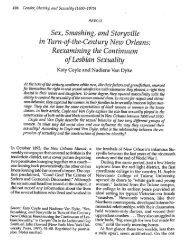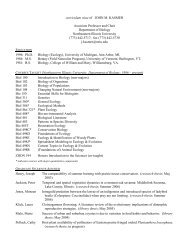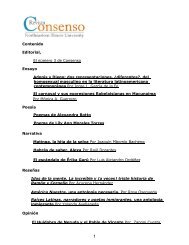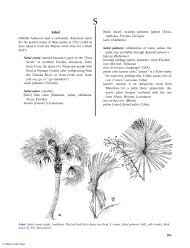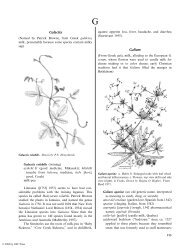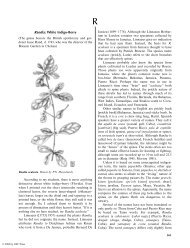Herba Cana - Northeastern Illinois University
Herba Cana - Northeastern Illinois University
Herba Cana - Northeastern Illinois University
You also want an ePaper? Increase the reach of your titles
YUMPU automatically turns print PDFs into web optimized ePapers that Google loves.
© 2004 by CRC Press<br />
The Ethnobotany 483<br />
Passiflora suberosa. Drawn by P.N. Honychurch.<br />
the flower, the crown of thorns. The calyx, the glory<br />
or nimbus. The white tint, purity. The blue tint,<br />
HEAVEN’’ (Coffey 1993). What most accounts do<br />
not add is the historical sequence behind that story.<br />
Nicolas Monardes was perhaps the first to use the<br />
Latin term Flos passionis (flower of the crucifixion) in<br />
1582. Since that story and the plant were not part of<br />
John Frampton’s ([1577] 1925) translation, Englishspeaking<br />
people were rarely aware of Monardes’s role.<br />
Supposedly, the same species was brought to Europe<br />
by Jac Boccio in 1610, and that introduction may have<br />
been the source of cultivated plants in England,<br />
Holland, and Sweden (Svanidze et al. 1974).<br />
The same passion-flower, later named P. incarnata,<br />
was mentioned by Strachey ([1612] 1953) on the James<br />
River of Virginia: ‘‘Here is a Fruict by the Naturalls<br />
called a Maracock this groweth generally lowe and<br />
creepeth in a manner amongest the Corne ... yt is of<br />
the bignes of a Queene-apple, and hath many azurine<br />
or blew kernells, like as a Pomegranett, and it<br />
bloometh a most ssweet and delicate flower, and yt is<br />
a good Sommer Cooling fruict, and in every field<br />
where the indigenous people plant their Corne be<br />
Cart-loades of them.’’ His original notes on the<br />
Powhatan used maracah (Harrington 1955). That<br />
same year Capt. John Smith reported that the<br />
indigenous people planted ‘‘Maracocks, a wild fruit<br />
like a lemmon, which also increase in fruit’’ (Coffey<br />
1993). Subsequently, herbalist Gaspar Bauhin recorded<br />
the species in 1623. Parkinson ([1629] 1976)<br />
wrote that the plant ‘‘Maybe called in Latine, Clematis<br />
Virginiana; in English, the Virgin or Virginia Climer;<br />
of the Virginians, Maracoc; of the Spanish in the West<br />
Indies, Granadillo, because the fruit ... is in some<br />
fashion like a small Pomegranate on the outside.’’<br />
However, it was the name Granadilla hispanis, flos<br />
passionis italis (little Spanish pomegranate, Italian<br />
passion flower) published by Francisco Hernández in<br />
his book of 1651 that was the earliest firsthand record<br />
Linnaeus had as the basis for Passiflora in 1753. Not<br />
only did Linnaeus have the description and drawing<br />
from Hernández, but he also knew that the plants had<br />
been cultivated in England from the 1600s. Indeed,<br />
Linnaeus had studied the live plants at the Hortus<br />
Cliffortianus (Holland) and Hortus Uppsaliensis (Sweden).<br />
All these names had been applied to the species<br />
that Linnaeus called P. incarnata (flesh-colored). He<br />
was mistaken about the flower color because they are<br />
blue.<br />
The Latin Flos passionis became flor de la pasión<br />
(Spanish), fleur de la passion (French), flor da paixão<br />
(Portuguese), and passion-flower as generic equivalents<br />
of the genus Passiflora. The apparent lone<br />
exception to these names is in Puerto Rico where the<br />
genus is called parcha (from palcha, Quechua). Today<br />
parcha is mostly associated with the introduced South<br />
American P. edulis. Probably the plant and its name<br />
were introduced at the same time from Peru where<br />
now P. edulis is called maracuya.<br />
The names maricock and maracocks gave rise to<br />
maracoc, maycock, maypop (Alabama, North Carolina),<br />
mayapple (Alabama, North Carolina), Mollypop<br />
(Alabama, North Carolina), pop-apple (North<br />
Carolina), apricot (North Carolina), and apricot-vine<br />
(Texas). All of these names are supposedly derived<br />
from mahcawq [mäkak, mä’kâwk] (Powhatan), akin to<br />
machkak (Menomini), mäkäk (Cree, Ojibwa), and<br />
ma’ka’kwi (Fox). Although similar, there seems to be<br />
no relation to Tupí mboruku’ya or maraú-yá, in<br />
Portuguese maracujá, and maracuya in Spanish,<br />
names for P. edulis (Gerard 1907).<br />
Passiflora incarnata is also known as granadilla<br />
(little pomegranate, Texas, Florida fide Williams<br />
[1837] 1962), Holy-Trinity flower (Texas), pasionaria<br />
(of the crucifixion, Texas), passion-vine (North Carolina),<br />
and purple passionflower (Florida). Opako is<br />
the Alabama name, and it is almost identical to the<br />
Koasati apakó, Muskogee opvkv [opv’kv], and Miccosukee<br />
opakî. Probably belonging here is làanasi (laana,<br />
yellow, osi, suffix meaning extremely, Alabama). The<br />
plant designated by the Alabama name is described as<br />
having a ‘‘small sweet melon, smells like a honeydew,<br />
makes the mouth itchy, size of an orange; a vine with a<br />
fruit similar to passion fruit (if one eats too much of it,<br />
it will blister the tongue and mouth)’’ (Sylestine et al.<br />
1993). The species ranges from Virginia to Missouri,<br />
south to Florida and Texas and Bermuda, and it is<br />
introduced farther north in the United States.<br />
In addition to eating the fresh fruits (uwa’ga), the<br />
Cherokee made a social drink of them, mixing the





